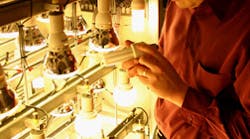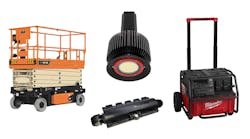Mandates in the Energy Independence and Security Act of 2007 call for lamps that use 25% to 30% less energy by 2014 and 70% less energy by 2020 — ostensibly putting the incandescent bulb out to pasture. With light-emitting diode (LED) technology still out of reach for the average consumer, this essentially paves the way for compact fluorescent lamp (CFL) products.
Already, many electric utilities have launched rebate programs offering free or low-cost CFLs to their customers. In addition, high-profile campaigns and higher energy costs have piqued consumer interest in energy efficiency and green products for their homes, resulting in increased sales of CFLs from big-box stores. The majority of bulbs being used to replace incandescent lamps are electronically ballasted, screw-base CFLs. Although some of the programs offering these types of bulbs require purchase of power factor-corrected bulbs to be eligible for rebates and other incentives, many do not.
Fight the power
CFLs can replace incandescent lamps roughly three to four times their wattage, saving up to 75% of the initial lighting energy, according to the U.S. Department of Energy (DOE). Yet, incandescent lamps use power as it is supplied by the electric utility, whereas electronically ballasted, screw-base CFLs must contain circuitry that corrects for poor power factor and total harmonic distortion (THD) ratings. When uncorrected, CFLs draw currents in bursts, altering the electricity that flows through them and increasing line losses on the electric utility network, which can cause transformers and cables to burn out more quickly. This has led to several recent studies that claim any efficiency gained through the use of electronically ballasted, screw-base CFLs with low power factor ratings and high THD percentages is lost in the transportation of power that runs through them. Some argue that electric utilities may begin charging residential customers fees to compensate for expensive corrective measures required to combat the problem and the additional generation resources required.
Uncorrected electronically ballasted, screw-base CFLs are not the only cause of non-linear loads from electrical devices in residential applications. Over the last two decades, the shift from simple mechanical devices to more sophisticated home electronics — such as audio and video equipment, personal computers, and microwaves/kitchen appliances — is also responsible for increases in THD to the voltage waveform that electric utilities supply to their residential customers. However, the recent meteoric rise in the popularity of this type of CFL has some industry experts warning against bulb-for-bulb replacement of incandescent lamps, even in the face of proven wattage savings.
How low can you go?
Power factor is the ratio of the real power flowing to the load to the apparent power. Power factor ratings range from 0 to 1, with 1 indicating a perfect power factor. When a load draws current that is not “in phase” with the voltage waveform, or draws a current that differs from the sinusoidal waveform provided by the electric utility, the power factor is less than 1. Poor power factor causes inefficiency in the delivery of electricity to the end-user, requiring more energy to compensate for losses on the line. For example, a load with a power factor of 0.5 will require twice as much current as a load with a power factor of 1 for the same amount of usable power.
Standards set by the American National Standards Institute (ANSI), Washington, D.C., and the National Electrical Manufacturers Association (NEMA), Rosslyn, Va., recommend a power factor of 0.9 or greater for electronic ballasts. Yet, Energy Star, the joint program of the U.S. Department of Energy (DOE) and the U.S. Environmental Protection Agency (EPA), requires a minimum power factor rating of 0.5 for screw-base, electronically ballasted CFLs. “In our testing for Energy Star, we haven't found any CFLs less than 0.5, but they're not 1, either,” says Peter Morante, director of energy programs for Rensselaer Polytechnic Institute's Lighting Research Center (LRC), Troy, N.Y.
For a variety of reasons, U.S. manufacturers have not produced many power factor-corrected CFLs. A lower power factor allows them to keep the cost of the bulbs down, which greatly helps market penetration. “The original thought was to let the power factor go a little bit lower to reduce the first costs of the lamps,” Morante explains. “For a rating above 0.5, you have to add something to the electronics, so that will up the cost of the lamp.”
Size is another factor in setting the power factor rating standard. “Any device that uses some sort of power supply or power filter is going to put some harmonic distortion into the load, because the only way to make it yummy and clean is to make it huge and expensive,” says Alex Boesenberg, technical manager for the Lighting Systems Division of NEMA. “There are people that make high power factor CFLs — I think all my manufacturers have a design handy if they need it — but the cost and the footprint of those things have made them undesirable.”
Even so, CFLs can cost three to 10 times more than comparable incandescent bulbs. In general, the higher the power factor, the higher the cost of the lamp. Under this rule, you get what you pay for, says Doreen LeMay Madden, founder and principal designer for Lux Lighting Design, Belmont, Mass., and chairman of the Residence Lighting Design & Application for the Illuminating Engineering Society of North America (IESNA), New York. At a power factor rating of 0.5, a 15W screw-in CFL will actually use 30VA of energy and, in some cases, the consumer may not be receiving the same light output the incandescent provided. However, the consumer may be unaware of this exchange rate.
Power quality has traditionally been thought of strictly as an issue for the electric utility. The electric meters on residences measure watts, so consumers realize the wattage savings indicated on the lamp's packaging through savings in their energy bill. “They'll see that 75% savings,” Morante says. “The meter on the house doesn't measure power factor.”
Unlike commercial customers, residential energy users currently aren't charged extra to compensate for loads with low power factors. “The end-users don't fully realize that these low power factor compact fluorescents are not using the small amount of energy that they think,” LeMay Madden says. “They're using twice the amount of energy, plus they're causing distortion in the sine wave. The lower the power factor, the more distortion you get.”
Residential customers wanting to use power factor-corrected bulbs may have a hard time figuring out which lamps at the store to buy. Power factor ratings are rarely included on the lamp packaging. “I really think they should mention on the packaging what the power factor is off the ballast,” LeMay Madden says. “But right now the consumer doesn't have that information, and they should be educated.”
Corrective measures
On the energy provider end, the wattage savings will be less than 75%. Yet, most energy providers champion residential CFL use, which, when compared to incandescent bulbs, decreases overall system load and generation needs. “There is a benefit to the distribution system: less generation and less amperage,” Morante says. “So there are those benefits even though power factor isn't what the electric utility might like it to be. You're still reducing wattage. It's just not a 75% reduction from a utility capacity standpoint.”
Even with a reduction in amperage, electric utilities must still correct for the THD caused by devices with power factors less than 1. To do so, they either add capacitors to the distribution system as close to the load as possible or increase generation capacity. A study from New Zealand estimates that correcting for low power factor electrical devices could cost electric utilities as much as $4 million for every million low power factor CFL bulbs installed. “Utilities have to compensate for this low-power factor distortion by purchasing more capacitors,” says LeMay Madden.
However, Morante argues against the idea that utilities will begin charging extra fees to pay for the corrections. “Obviously, there is a cost to make these corrections,” he says. “It's there today. For residential customers, it's in their kilowatt-per-hour charge.”
Some experts say that single-phase residential systems only require minimal corrections by the electric utilities. The harmonics generated by electronically ballasted, screw-base CFLs, as severe as they are, are essentially “no sweat,” especially in residential applications, says Oliver Morse, formerly with the Lighting Systems Research Group, Applied Science Division, Lawrence Berkeley Laboratory, Berkeley, Calif. According to Morse, in homes there is enough resistive load from electric ranges and refrigerators that, when combined with the low power factor devices, make corrections a non-issue. “Dirty power and harmonics are less of a problem in single-phase systems than in 3-phase systems,” Morse says. “There's enough clean power consumed by motors driving refrigerators, fans, air-conditioners, and electric ranges.”
The power distribution system acts as giant low-pass filter, according to Morse. Transformers contain inductors, and transmission lines have inductances and parasitic capacitances that tend to reduce harmonics as reflected back through to the generation system. “I would guess that the utilities don't even see it at the generation station,” Morse says. “Only the transformers in the local neighborhoods — where the harmonics are generated — would see it, so they should take some readings. But I would not be awfully worried about it. It's such a small percentage of the total load.”
Critical mass
In its 1999 paper, “Power Quality Implications of Compact Fluorescent Lamps in Residences,” the Lamp Section of NEMA wrote, “Using screw-in low power factor CFLs in hotels, motels, and retail stores have not proven to create any power quality issues for users or utilities since the CFL load tends to be relatively small compared to other loads.” But what happens when CFLs comprise more of the load? “If you have hundreds of homes on one particular grid and everyone screws in these low-power factor lamps, that can affect the distortion of the sine wave exponentially,” LeMay Madden says.
However, others disagree about the cumulative ability of CFLs to bring down the grid. “I'm not certain there is a critical mass, per se,” says Boesenberg. “The harmonic distortion the utilities deal with is there regardless of whether there are any CFLs at all. There are thousands of utilities in the United States after the deregulation in the '70s, so I think they must all deal with it in their own way.”
Currently, electronically ballasted, screw-base CFLs still comprise a fairly small percentage of the total residential load. The bulk comes from electrical motors. “Electrical motors are the biggie, as far as volume or the amount of correction required,” Morante says.
Even so, residential CFL use — the bulk of it screw-base models — is on the rise. In 2007, sales for Energy Star-rated CFLs totaled 290 million, according to a recent report from the EPA. Although the total accounted for approximately only 20% of the total U.S. light bulb market in 2007, it amounted to nearly double the number sold in 2006.
In applications where higher quantities of CFLs are specified and where the load would be a higher proportion of the total connected load, recommends NEMA in its report, it would be expected and recommended that luminaires designed for pin-based (plug-in) CFL lamps and separate ballasts be used rather than screw-base CFLs. Ballasts for such applications are available in power factors equal to or greater than 0.9 and THD ratings less than 32%.
There are also power factor- and THD rating-corrected versions available on the market. Green Seal, a Washington, D.C.-based nonprofit organization that develops standards and product certifications designed to reduce the environmental effects associated with the manufacture, use, and disposal of products, has developed its own rating system. Its Class A CFL rating demands a power factor rating of at least 0.9 and THD of less than 33%. When used according to their specifications, electronically ballasted, screw-base CFLs can provide energy efficiency and a long bulb life (See Best Practices for CFLs).
Sidebar: Best Practices for CFLs
Compact fluorescent lamps (CFLs) come in several sizes and configurations and can be energy-efficient solutions for many lighting situations. Not all CFLs are designed to work in every socket. “The CFL is not the perfect answer for all your needs,” says Alex Boesenberg, technical manager, Lighting Systems Division, National Electrical Manufacturers Association (NEMA), Rosslyn, Va. To determine if a CFL will work in your specific application, read the packaging and also check out the following tips on how to best use CFLs:
-
To determine the approximate equivalent incandescent lamp watts, multiply the compact fluorescent watts by 3.5.
-
Use CFLs in places where you will have the light on for at least 15 min. at a time. Frequently turning a CFL on and off will shorten the bulb's life.
-
When choosing a CFL replacement, be careful to use a lamp that has a very similar size, shape, and lumen output to the original incandescent. Most CFLs do not produce enough light for high-ceiling (above 12 ft) ambient lighting applications
-
Although most CFLs come in “warm” colors to match the yellowish light output of incandescent bulbs, you can also choose “cooler” colors with whiter and bluish hues for reading and task lighting. Check the packaging for the color measurement. For warmer color, look for 2,700°K to 3,000°K, 3,500°K to 4,100°K gives a bright white light, and 5,000°K to 6,500°K is a bluer white and most like daylight.
-
CFLs are designed to operate within a specific temperature range. Temperatures below the range cause reduced output. Most CFLs are for indoor use, but there are models available for outdoor use. These bulbs have special cases that protect them from the elements. Placing a bare spiral CFL in an open outdoor fixture exposes the tubing and electronics to the elements and is likely to result in an early failure. If you live in a cold climate, check the packaging for starting temperatures to make sure the bulb will work properly.
-
Most photocells and timers are not designed to work with CFLs. Check with your photocell or timer manufacturer for compatibility.
-
Fixtures or lamps with dimmer switches require the use of dimmable CFLs. Not every CFL is dimmable, so check the packaging to make sure it is. Dimmable CFLs work differently than incandescent bulbs. Incandescents dim smoothly from 100% of their light output to no output, and their light color changes from a bright white to a warmer yellow. Dimmable CFLs maintain light color more consistently and dim to 10% to 40% of their original brightness. Dimmable bulbs typically come in soft white color temperature.
-
For use in ceiling fixtures, ensure there is enough airflow to prevent excessive heat from shortening the life or decreasing the amount of light the CFL gives off.
-
CFLs are not appropriate for certain situations, such as accent lighting or glittery retail display, where tight beam spread or sparkle is needed.
-
The ability to provide a concentrated narrow beam of light is greatly reduced because the CFLs do not have a single-point source of the light produced. If an outdoor luminaire is to provide a concentrated beam of light that must travel great distances (such as a spotlight on a reader board at some distance), then an incandescent product with a reflector is likely a better choice. However, this does not create any problems for the vast majority of cases where general doorway, façade, or walkway illumination is required.
-
Indoor reflector light bulbs work best in track lighting and some recessed cans, because they are specially designed to direct the light out of the fixture and to withstand the heat buildup that occurs in these fixtures. Better-quality recessed lights do not require the light bulb to have a reflector, because their trims act as reflectors and are well-designed to distribute the light.
-
When your CFL burns out, recycle it. Go to www.epa.gov/bulbrecycling for recycling locations.
-
If a bulb breaks, follow the guidance found at www.energystar.gov/CFLsandMercury.




